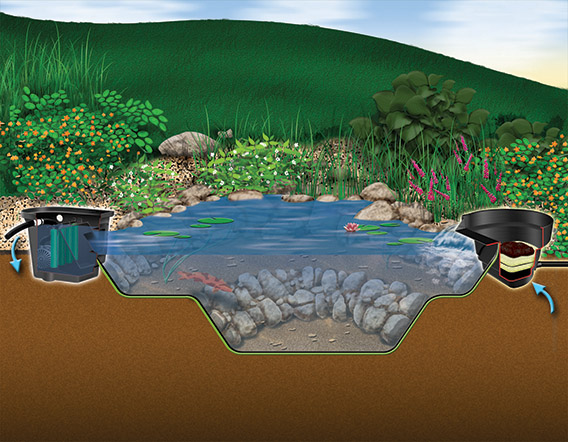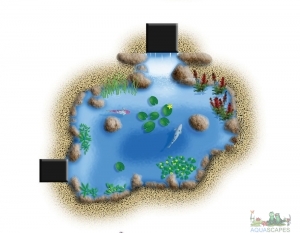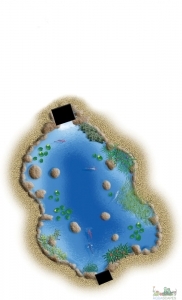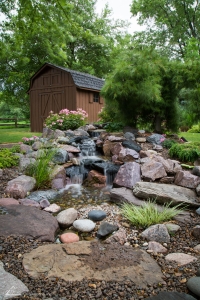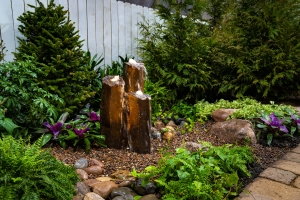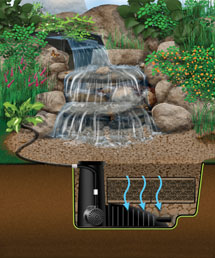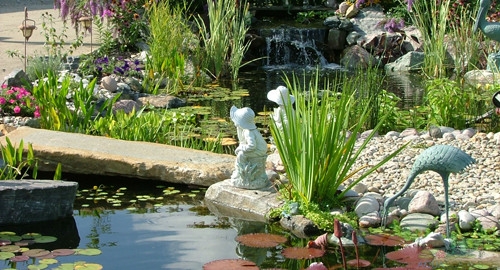Best Pond Pump Information 2021
Pumps keep the water in your pond healthy. They help evenly spread nutrients in the water to fish, plants and other aquatic life. Running water prevents stagnation and cuts down on algae and mosquitoes. Keeping the water moving ensures that oxygen levels are distributed throughout the pond. Pumps also provide power for a pond’s water features, like waterfalls and fountains.
This guide will help you learn about the best pond pumps for your garden.
~
The best water pumps for your pond and its fountain or waterfall come in variety of types and styles. They include submersible, external, magnetic drive and direct drive. Each of these water garden pumps offers its own advantages.
Submersible Pumps: These pumps are designed to work while wholly submerged in water. Typically, they are installed in the deepest part of the pond. Submersible pumps can be placed either directly into your pond or in a skimmer box or pond vault.
- Easy to install.
- Work well in environments that capitalize on a natural setting.
- No need to camouflage the pump.
- Run very quietly so there’s no distracting noise in your garden.
- Submersible pumps can be used to drain your pond, if needed.
- Range in pumping size from 50 to 5,000 gallons per hour.
- Can generate higher energy costs than other pump types.
- For smaller ponds, submersible pumps are generally more economical.
Tip: Some submersible pumps use oil to operate. If the pump seal breaks and leaks harmful oil coolant into the water, fish can be hurt or killed. If you have fish or other aquatic life in your pond, you’ll want to look for a submersible model that does not use oil.
External Pumps: External pumps can move a high volume of water, yet usually have lower energy costs than submersible pumps. They are not as quiet as submersible pumps. They should be placed in a dry location near your pond. External pumps are a lot more complicated to install. However, they are generally more reliable.
- Available as self-priming pumps able to draw their own water.
- Can be loud, disturbing the quiet of your garden.
- Work well for larger ponds that are 1,000 gallons or more.
- Offer long-lasting performance and easy repair.
- Require less routine maintenance than submersible pumps.
Tip: Pumps that are not self-priming can burn out a motor if the power shuts off momentarily and then comes back on. Protect against this by installing a check valve.
Magnetic Drive: In a magnetic-drive pump, an electrical charge creates a magnetic field that causes the magnet on the impeller to rotate and pump water. Since they have no seals to wear out, they require little maintenance. Occasionally, you will need to clean the impeller and its chamber for the most efficient operation.
- Completely sealed. Magnetic-drive pumps do not require lubrication.
- Because they don’t contain oil, magnetic-drive pumps are safer for ponds with fish, since oil leaks don’t occur.
- Don’t generate high head heights. Magnetic-drive pumps are unable to lift pond water vertically, which you might need to supply water to a fountain. They are not the best water pumps for fountains.
- Work best in cleaner environments with little or no debris.
- Highly efficient and cost-effective.
Direct Drive: Direct-drive pumps have an enclosed motor that is powered by electricity, which turns the impeller shaft.
- Achieve significant head height, so they are able to move water vertically. They are among the best water pumps for fountains and waterfalls.
- Typically more expensive to operate.
- Push water rather than pulling it.
- Not easily repaired.
Tip: Some models seal the motor in an oil-filled shell with seals around the cord and impeller shaft. These are risky to use if you have a pond stocked with fish. There is an ever-present danger of water contamination if a leak occurs. Many newer pumps, however, feature alternative lubrication that is safe for fish. Look for oil-free models if you have fish or other aquatic life in your pond.
Pond Pump Calculations
Pond Pump Features
Product Comparison: Pond Liners vs. Concrete
Battle of the Pond Foundations:
LINERS vs. CONCRETE
How to choose the right base for your backyard pond.
Creating a serene pond in your backyard is a fantastic way to enhance your outdoor living space. As pond owners, you’ll face crucial decisions to ensure the long-term durability of your water feature. One of the primary choices is whether to opt for pond liners or concrete as the foundation for your aquatic haven. In this blog post, we’ll compare the pros and cons of both options, helping you make an informed decision that suits your needs and the unique characteristics of the Cincinnati climate.
Pond Liners:
Pond liners have become a popular choice for many pond owners due to their flexibility, cost-effectiveness, and ease of installation. Here are the key pros and cons:
Concrete:
Concrete is a traditional and durable choice for pond construction. Let’s delve into the advantages and disadvantages:
PROS
Pond Liner Pros:
Concrete Pros:
CONS
Pond Liners Cons
Concrete Cons:
Ultimately, choosing between pond liners and concrete for your Cincinnati pond comes down to your preferences, budget, and long-term goals. If you prioritize flexibility, cost-effectiveness, and easy installation, pond liners may be the way to go. On the other hand, if longevity, sturdiness, and customization are crucial factors, investing in a well-constructed concrete pond may be the ideal choice. Whichever option you choose, ensuring proper maintenance and care will contribute significantly to the enduring beauty of your aquatic retreat.
Check out our store for all your water gardening needs! Aquascape products are Aquascape Inc. Certified.
Thanks for reading at Meyer Aquascapes! We hope you’ve enjoyed our post on garden pond design. Please leave a comment below if you liked it or have any questions. We’d love to hear from you! Thanks for stopping by!
How can we help?
The Art of Creating a Serene Oasis: Design Tips for Aquascaping Beginners
Aquascaping, the art of designing and arranging a natural aquatic wonderland in an aesthetically pleasing way, has become a popular hobby for those seeking to create serene outdoor environments. Whether you’re a newcomer to the world of aquascaping or a seasoned enthusiast looking to refine your skills, this post will offer essential design tips to help you transform your outdoor pond into a tranquil oasis.
Grasp the Fundamentals:
Before embarking on your aquascaping journey, it’s essential to understand the basics. Familiarize yourself with principles like balance, contrast, and focal points, guiding you in creating visually appealing and harmonious outdoor landscapes.
Embarking on the captivating venture of aquascaping demands a foundational grasp of essential principles that form the backbone of creating an enchanting outdoor oasis. Delving into the intricacies of pond design, one must first acquaint themselves with fundamental concepts such as balance, contrast, and focal points. Achieving balance involves a harmonious distribution of elements within the pond and its surroundings, ensuring a sense of equilibrium that pleases the eye. Conversely, contrast introduces diversity and visual interest by juxtaposing different colors, textures, and shapes. Meanwhile, the strategic placement of focal points adds a captivating centerpiece, drawing attention and establishing a visual anchor within the landscape. These principles collectively guide the journey, transforming it into an artful process where nature and design intertwine to create a visually stunning and harmonious outdoor space.
Applying the principle of balance might involve distributing aquatic plants evenly throughout the pond, ensuring that the visual weight is harmonious. For instance, placing taller plants on one side could be balanced by shorter plants on the opposite side, creating equilibrium. Introducing contrasting elements could involve incorporating different types of flora with distinct colors or textures. For example, the vibrant hues of water lilies contrasting with the delicate foliage of submerged grasses can add visual interest to the pond’s ecosystem. As for focal points, a strategically positioned decorative feature, such as a fountain or a cluster of ornamental rocks, could serve as a captivating centerpiece, drawing attention and providing a stunning show-stopper. By understanding and implementing these principles, pond enthusiasts can craft outdoor environments that embody aesthetic appeal and maintain a sense of harmony and balance within the natural surroundings.
Select the Right Pond and Equipment:
Choosing the appropriate pond size and shape is fundamental for successful aquascaping. Consider the available space in your outdoor area and the kind of aquatic life you intend to include. Invest in quality equipment such as pumps, filters, and aeration systems to maintain a healthy pond ecosystem.
Selecting the right pond size and shape is crucial to creating a thriving aquascape. The decision should be based on a thoughtful evaluation of your outdoor space, considering its dimensions, overall layout, and aesthetic appeal. Before breaking ground, research the type of aquatic life you envision inhabiting the pond, as different species may have varying space and environmental requirements. This will guide you in tailoring the pond’s features to meet the needs of the inhabitants, ensuring a harmonious and balanced ecosystem.
In addition to designing the pond with its occupants in mind, it is equally important to invest in high-quality equipment to guarantee the pond’s long-term health and vitality. Essential components such as efficient pumps, reliable filters, and effective aeration systems play pivotal roles in maintaining optimal water quality. A well-circulated and properly filtered pond not only sustains the health of aquatic life but also enhances the overall beauty of the landscape. Furthermore, these equipment choices can contribute to the prevention of issues such as algae overgrowth and stagnant water, promoting a visually appealing and ecologically sound pond environment.
By meticulously planning the pond’s size and shape and complementing it with top-notch equipment, you lay the foundation for a successful pond that will affect aesthetic preferences and support a flourishing ecosystem. Carefully integrating space, aquatic life, and quality equipment ensures that your pond becomes a captivating focal point in your outdoor space, fostering a balance between aesthetics and ecological sustainability.
Integrate Hardscape Elements:
Incorporating hardscape elements into your pondscape design is a transformative step that introduces a captivating interplay of texture and dimension to your aquatic oasis. Strategically positioned rocks and boulders can serve as more than mere decorative features; they contribute significantly to the overall aesthetic appeal and functionality of the pond environment. Choosing hardscape elements that align with the natural theme you envision is crucial, as they play a pivotal role in creating a harmonious and balanced layout.
The addition of rocks and boulders enhances the visual appeal and provides practical benefits. They can act as shelter and resting spots for aquatic inhabitants, fostering a more natural and dynamic habitat. Carefully selecting substrate materials and placing them strategically on the pond floor further enhances the texture and complements the hardscape elements. This thoughtful integration of rocks, boulders, and substrate helps recreate the complexity and diversity found in natural aquatic environments.
To achieve the desired visual impact, it’s advisable to experiment with different arrangements of hardscape elements. Play with varying sizes, shapes, and orientations to find the most aesthetically pleasing and harmonious configuration. By doing so, you can create visually engaging focal points and pathways that draw attention to your pond’s unique features. Additionally, the strategic placement of hardscape elements can contribute to the illusion of depth and perspective, making your pond feel more expansive and immersive.
In essence, including hardscape elements in your design is an artful endeavor that goes beyond mere decoration. It is an opportunity to sculpt a landscape that not only captivates the eye but also enhances the ecological functionality of the pond. Thoughtful consideration of how rocks, boulders, and substrate elements interact with the overall theme ensures that your aquatic oasis becomes a balanced and natural haven, where form and function coalesce to create a visually stunning and ecologically vibrant space.
Here are a few favorite types commonly used:
River Rocks:
Smooth, rounded river rocks are popular for their natural appearance and ability to create a serene, riverbed-like setting within the pond. They come in various sizes and colors, allowing for versatile design options.
Granite Boulders:
Granite boulders are durable and add a rugged, earthy texture to the pond. They come in different sizes and colors, creating a more natural and visually appealing landscape.
Lava Rocks:
- Lightweight and porous, lava rocks are excellent for biological filtration and provide a habitat for beneficial bacteria. They come in various sizes and are often used in the waterfall or filtration areas of the pond.
Slate:
- Flat, smooth slate rocks are perfect for creating ledges or stepping stones within the pond. They add a modern touch and can be placed strategically to create interesting visual pathways.
Pebbles and Gravel:
- Small-sized pebbles and gravel serve as excellent substrate options for the pond bottom. They come in various colors and sizes, providing a natural substrate for aquatic plants and creating a more natural appearance.
Sand:
- Fine-grained sand is suitable for creating a beach-like area within the pond or providing a comfortable substrate for certain fish species. It can enhance the overall aesthetics while serving functional purposes.
Quartzite:
- Quartzite rocks offer a glittering and often multicolored appearance, adding a touch of elegance to the pond. They are particularly eye-catching when used as accent pieces or combined with other rocks.
Cobblestones:
- These larger, rounded stones are ideal for creating defined edges around the pond or for lining pathways. They provide a visually appealing border and can be placed strategically for aesthetics and stability.
Research and Choose Suitable Plants:
Aquatic and marginal plants are pivotal in creating a natural and serene atmosphere around your outdoor pond. Research various plant species and select those that thrive in your local climate and pond conditions. Incorporate a variety of plant shapes, sizes, and colors to add depth and interest to your pond.
A thoughtful approach to plant selection involves conducting thorough research on various plant species, taking into consideration not only their aesthetic appeal but also their compatibility with the local climate and specific pond conditions. Choosing plants that are well-suited to the regional weather patterns and water parameters ensures their resilience and longevity, contributing to a flourishing pond ecosystem.
Diversity is key when integrating aquatic and marginal plants into your pond design. Incorporating a variety of plant shapes, sizes, and colors adds a dynamic and layered dimension to the landscape. Tall and gracefully arching plants, such as cattails or iris, can provide vertical interest and serve as focal points while floating plants like water lilies contribute a sense of tranquility and natural balance. Additionally, low-growing marginal plants around the pond’s edge softens the transition between water and land, creating a seamless and harmonious blend with the surrounding landscape.
Beyond their visual appeal, aquatic plants contribute to the overall health of the pond ecosystem. They play a crucial role in oxygenating the water and provide habitat and shelter for aquatic life. The strategic placement of plants also helps in nutrient absorption, preventing excessive algae growth and maintaining water clarity.
As you embark on the selection and placement of aquatic and marginal plants, consider the seasonal variations in their growth patterns and flowering times. This thoughtful planning ensures that your pond remains visually captivating throughout the year, with a changing tapestry of colors and textures.
Mindful Consideration of Lighting:
Appropriate lighting is crucial for plant health and your outdoor pond’s visual appeal. Choose lighting that enhances the natural beauty of your pond and its surroundings. Consider solar-powered lights for a sustainable and enchanting nighttime ambiance.
Establishing suitable lighting for your outdoor pond is a pivotal consideration, influencing the well-being of aquatic plants and the overall visual allure of your aquatic haven. Opting for lighting solutions that accentuate the inherent beauty of your pond and its surroundings is essential in creating a captivating and harmonious atmosphere. A thoughtful selection of lighting fixtures can transform your pond into a stunning focal point, especially during the evening hours. Solar-powered lights emerge as a sustainable and enchanting choice, blending ecological consciousness with aesthetic appeal.
The strategic placement of lights around the pond’s perimeter or submerged beneath the water’s surface can highlight key features such as cascading waterfalls, gracefully floating plants, and the intricate details of rocks and substrate. This not only elevates the pond’s aesthetics but also extends the enjoyment of its beauty into the nighttime hours. Solar-powered lights, harnessing the energy of the sun, exemplify an eco-friendly approach, minimizing environmental impact while ensuring a cost-effective and low-maintenance lighting solution.
These lights contribute to the enchanting ambiance and serve a practical purpose by enhancing visibility around the pond, creating a safe and inviting space for evening strolls or gatherings. Furthermore, the gentle glow of solar-powered lights can create captivating reflections on the water’s surface, adding an extra layer of charm to the pondscape.
Here are some common types of pond lighting and their differences:
- Submersible Pond Lights:
- Placement: These lights are designed to be submerged in the water, typically placed at the bottom of the pond.
- Purpose: Submersible lights highlight underwater features, such as fish, plants, rocks, and substrate.
- Variations: Available in LED or halogen options, with different color choices for creating different moods.
- Floating Pond Lights:
- Placement: These lights float on the water’s surface.
- Purpose: Floating lights add an enchanting touch to the pond’s surface, creating reflections and illuminating floating plants or decorations.
- Variations: Solar-powered or battery-operated options, with variations in color and intensity.
- Underwater Pond Lights:
- Placement: Installed below the waterline on the sides or bottom of the pond.
- Purpose: Underwater lights accentuate the depth and dimensions of the pond, highlighting underwater features and creating a visually dynamic environment.
- Variations: LED or halogen lights with adjustable angles for versatile illumination.
- Spotlights and Uplights:
- Placement: Positioned around the pond’s perimeter, directed toward the water.
- Purpose: These lights emphasize the surrounding landscape, waterfalls, and plants, enhancing the overall aesthetic appeal of the pond area.
- Variations: Available in various wattages and beam angles, highlighting specific elements flexibly.
- Path Lights:
- Placement: Placed along pathways or around the pond’s edge.
- Purpose: Path lights enhance safety and visibility while contributing to the overall lighting design of the pond area.
- Variations: Solar-powered or low-voltage options with various designs and finishes.
- Solar-Powered Pond Lights:
- Power Source: Operate using solar energy collected during the day.
- Purpose: Eco-friendly and cost-effective solar-powered lights are suitable for various pond lighting applications, including submersible, floating, or pathway lighting.
- Variations: Available in different styles, colors, and intensities.
- LED Pond Lights:
- Light Source: Use Light Emitting Diodes (LEDs) for illumination.
- Purpose: LED lights are energy-efficient, durable, and come in various colors, making them versatile for different pond lighting needs.
Variations: RGB (color-changing) LEDs, single-color LEDs, and adjustable brightness options.
Establish a Focal Point:
Every successful pondscape benefits from a well-thought-out focal point. This could be a stunning plant arrangement, a captivating rock formation, or an eye-catching water feature. Experiment with different focal points until you discover one that enhances the overall aesthetic of your outdoor pond.
A pivotal component of every successful aquascape is the deliberate inclusion of a well-conceived focal point. Acting as the visual centerpiece that draws the eye and imparts a sense of balance and harmony to the entire outdoor pond environment. This focal point serves as a captivating anchor around which the rest of the elements can coalesce to create a unified and visually engaging landscape.
It can take on various forms, such as an artfully arranged cluster of vibrant aquatic plants, a meticulously positioned and visually striking rock formation, or a dynamic water feature that adds movement and auditory allure to the surroundings. The key is to experiment, trying out different configurations and focal points until you unearth the one that resonates most profoundly with your vision for the pond. This experimentation allows for the exploration of diverse design possibilities. It facilitates the discovery of a focal point that seamlessly integrates with the natural elements of your outdoor space, enhancing the overall aesthetic appeal of the pond.
Whether it’s the graceful sway of aquatic plants, the rugged beauty of strategically placed rocks, or the soothing sounds of cascading water, the chosen focal point should encapsulate the essence of your aquatic garden, transforming it into a captivating and harmonious haven that beckons admiration and contemplation.
Consistent Maintenance:
Regular maintenance is essential to maintaining the beauty of your pond. Trim overgrown plants, remove debris, and monitor water quality to ensure a thriving pond ecosystem. A well-maintained outdoor pond looks captivating and provides a peaceful haven for you and your pond’s inhabitants.
Consistent and thorough maintenance is the cornerstone of preserving the exquisite beauty of your aquatic paradise. Beyond the initial design and installation, taking proactive steps to care for your outdoor pond ensures it remains a vibrant and flourishing ecosystem. Regular maintenance tasks encompass a range of activities, including the meticulous trimming of overgrown aquatic plants, which maintains the aesthetic balance and promotes the health of the entire pond. Removing excess foliage prevents overcrowding, allowing each plant to receive adequate sunlight and nutrients for optimal growth.
Equally important is the diligent removal of debris, such as fallen leaves, twigs, and other organic matter, which can accumulate on the water’s surface or settle at the bottom of the pond. This debris detracts from the visual appeal and, if left unchecked, can compromise water quality and disrupt the delicate balance of the pond ecosystem. Regular cleaning routines, including the use of skimmers and pond vacuums, play a crucial role in sustaining a pristine and clear water environment.
Monitoring water quality is a fundamental aspect of pond maintenance. Testing for parameters such as pH, ammonia, nitrites, and nitrates ensures the water remains within optimal ranges for aquatic life. Proper filtration systems, regular water changes, and the addition of beneficial bacteria contribute to a balanced and healthy pond environment.
A well-maintained outdoor pond goes beyond visual aesthetics; it transforms into a peaceful haven for both you and the pond’s inhabitants. Clarity of the water, vibrancy of the plants, and the overall tidiness of the pond create a serene atmosphere that invites relaxation and contemplation. This meticulously cared-for space becomes a refuge, allowing you to connect with nature and appreciate the symbiotic relationship between the various elements of the pond ecosystem. In essence, the commitment to regular maintenance preserves the captivating allure of your aquascape and fosters a thriving and harmonious aquatic environment that can be enjoyed for years to come.
Pond maintenance varies by season, and adapting your care routine to the changing needs of the ecosystem ensures a healthy and visually appealing pond throughout the year. Here’s a summary of the essential maintenance tasks for each season:
Adapting your maintenance routine to the specific demands of each season helps keep your pond in optimal condition, supporting a thriving ecosystem and preserving its aesthetic appeal. Regular monitoring and adjustments based on seasonal changes contribute to your outdoor pond’s long-term health and beauty.
Conclusion:
Aquascaping is a gratifying and creative endeavor that allows you to transform your outdoor pond into a tranquil haven. By understanding the fundamentals, choosing the right equipment, selecting suitable plants, integrating hardscape elements, considering lighting, establishing a focal point, and practicing consistent maintenance, you can create a stunning pond, waterfall, or fountain that brings serenity and beauty to your outdoor space. Whether you’re a novice or an experienced, the art of crafting a tranquil haven is at your fingertips. Immerse yourself in the process and let your creativity flourish around the shores of your outdoor pond.
Check out our store for all your water gardening needs! Aquascape products are Aquascape Inc. Certified.
Thanks for reading at Meyer Aquascapes! We hope you’ve enjoyed our post on garden pond design. Please leave a comment below if you liked it or have any questions. We’d love to hear from you! Thanks for stopping by!
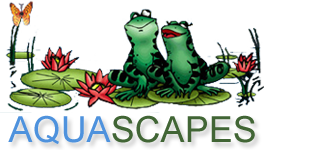
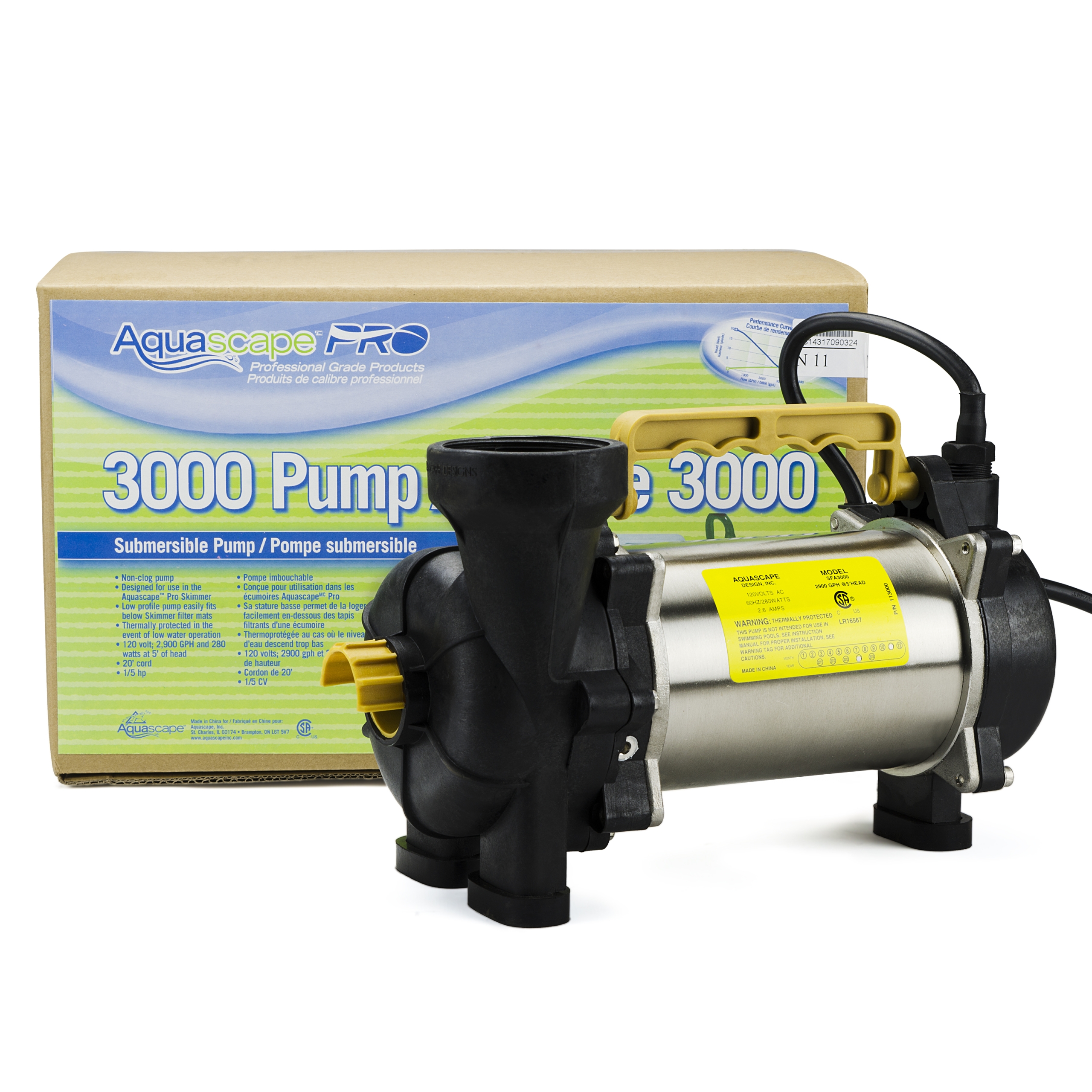
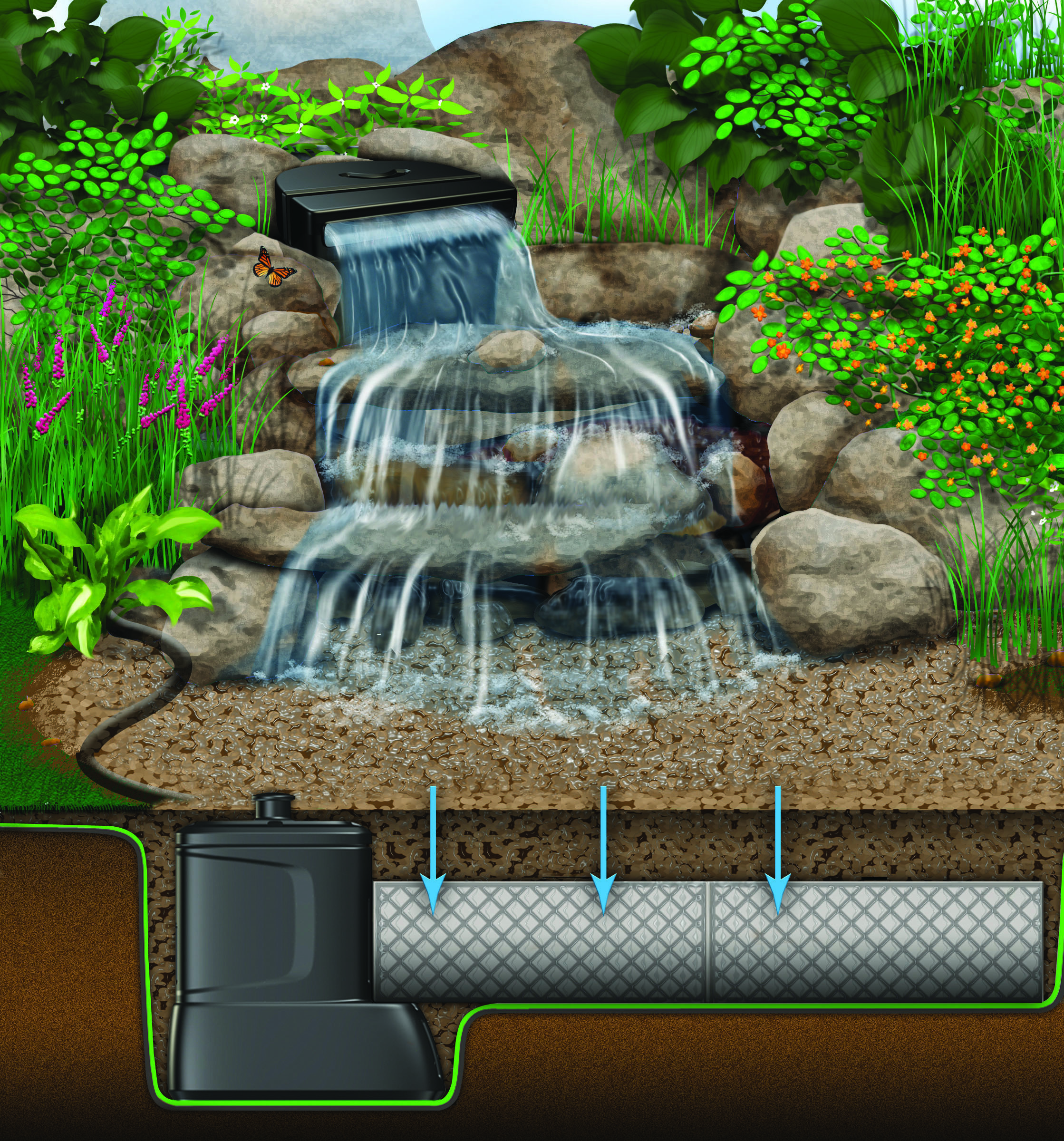


 Meyer Aquascapes
Meyer Aquascapes